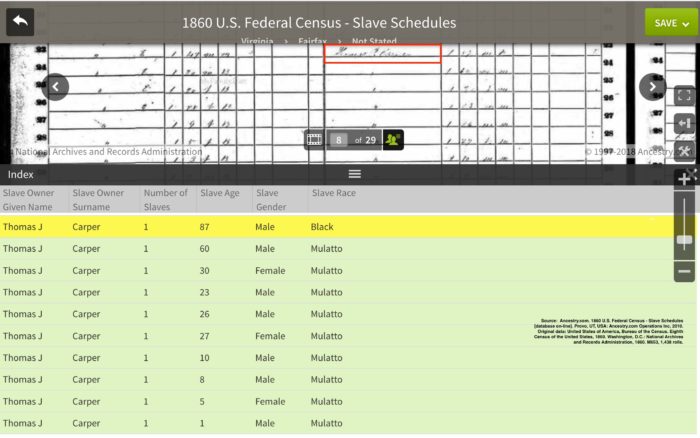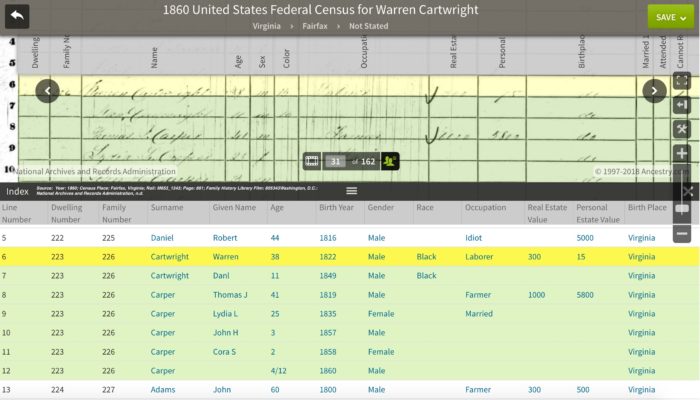

Census and deed records document that Thomas Carper sold part of his land to another of his former slaves, Warren Cartwright. Here is what Curtis L. Vaughn wrote on page 178 of his George Mason University dissertation, “Freedom is Not Enough: African Americans in Antebellum Fairfax County”.
“In 1858, Warren Cartwright, age thirty-eight, purchased four acres of land from Thomas Carper, age forty-one, for $100. The property sold was a small part of Carper’s land holdings. Warren Cartwright was not registered as a free African American in Fairfax County records, and the origin of his freedom is unknown. Three years earlier in 1855, Thomas Carper had freed two slaves named William and Daniel. In his manumission deed, Carper explained that they were the children of a slave named Mary whom he acquired in 1844 along with another woman named Anna Maria. In 1860, Carper still owned ten slaves, nine of whom were listed as mulattoes. Carper’s reason for the manumission of William and Daniel and their ancestry is unclear, although they may have been related to Warren Cartwright. In 1860 Cartwright gave a deed of trust in the amount of $110 in favor of Carper, even though he and 11 year-old Daniel Cartwright are listed in that year’s census as living in the Carper’s household. Unlike most of Carper’s slaves, the census describes the two Cartwrights as “black” indicating that they were not related to Carper. The whereabouts of William is unclear. One possible explanation is that William and Daniel were Warren Cartwright’s children by the slave named Mary. If the freedom of Cartwright’s mother dated prior to 1806, he would not have been threatened with deportation from Virginia; however if Mary had been manumitted, she may not have gained permission to remain in the state. If still living in 1860, William would have been around fourteen, an age at which he may have felt compelled to leave the area, but eleven-year-old Daniel might not have felt the same pressure to leave. Warren Cartwright may have been able to feed a family with the products from his small farm but his co-residence with Carper suggests that Cartwright’s four acres of land did not allow him full independence.”
Three child slaves emancipated by Carper in 1855 were required to register with the Fairfax County Court Clerk, and their names were written in the Registration of Free Negroes book. According to Victoria Thompson with the Fairfax Circuit Court Historic Records Center, this served two purposes:
1. Emancipated slaves could prove that they were free in case someone tried to pretend the freed person(s) in question were enslaved to them.
2. The courts knew where the emancipated slaves were living and if they had permission to stay in their county of registration. (Contextual Note: Many whites had a continued fear of slave rebellion after the 1931 Nat Turner uprising when 55 whites were killed by about 50 slaves led by the deeply religious Black preacher.)
DOUBLE CLICK HERE: Register of Free Negroes, p. 223 & 224
DOUBLE CLICK HERE: Fairfax Court Order Book 1852, p. 397, April 16th, 1855
DOUBLE CLICK HERE: Fairfax Court Order Book 1852, p. 398, April 16th, 1855